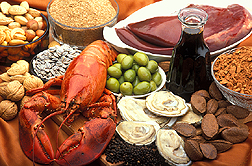This page has been archived and is being provided for reference purposes only. The page is no longer being updated, and therefore, links on the page may be invalid.
|
|
|
|
Dietary Copper May Ease an Ailing Heart
By Rosalie Marion Bliss
March 22, 2007
A new animal study adds to evidence that including foods rich in copper, along with a well-balanced diet, may be good for an ailing heart. The study appears in the March 19 issue of the Journal of Experimental Medicine.
Retired physiologist Jack Saari participated in the study while with the Agricultural Research Service (ARS) Grand Forks Human Nutrition Research Center in North Dakota. Lead author Y. James Kang conducted the study at the University of Louisville Medical Center in Kentucky.
Copper is an essential trace element that acts as a cofactor for the physiological function of many proteins. Tiny amounts are contained in hundreds of copper-dependent proteins that perform essential biological functions in animals and humans.
Hypertrophy is an increase in the size of a tissue or organ. For the study, the researchers challenged two groups of mice for two months, resulting in cardiac hypertrophy—a condition in which the heart becomes bigger followed by disease. Enlarged hearts often occur in response to elevated blood pressure.
Both groups were fed the equivalent of the recommended dietary amount of copper for adults for the entire two months. But after the first month, the test group's diet was increased to contain the equivalent of three times the human recommended amount of dietary copper—an amount that was still just one-third of the equivalent safe upper limit for humans.
By four weeks, heart disease developed in all the mice, and by eight weeks, heart failure developed in the control mice. But the hearts of the mice receiving the extra copper returned to normal size and function, despite the fact that the cardiac challenge continued throughout the eight-week period.
In human hypertrophic heart disease, enlarged heart muscle leads to shortness of breath during exertion, discomfort caused by reduced blood supply to the heart muscle and/or abnormal heart rhythms.
Confirmational, controlled human research studies are needed in which volunteers with hypertrophic heart disease consume copper-rich diets. But this mouse study suggests that consuming more copper in the diet may help people with hypertrophic, or thickened, heart muscle conditions.
For a list of foods that are good sources of copper, go to www.nal.usda.gov/fnic/foodcomp/Data/SR17/wtrank/wt_rank.html and click on "copper." The list will sort foods in descending order by copper content in terms of common household measures.
ARS is the U.S. Department of Agriculture's chief scientific research agency.

